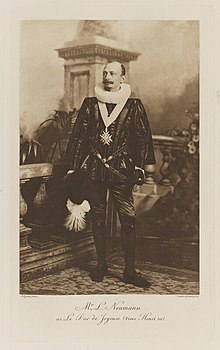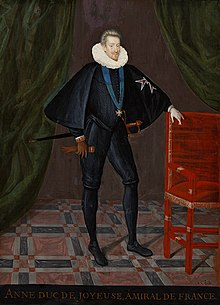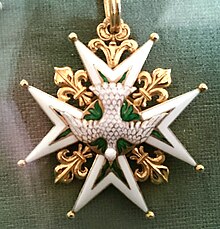Social Victorians/People/Neumann
Also Known As
[edit | edit source]- Family name: Neumann
- One of the "Randlords" (see Notes and Questions #1, below)
Relations
[edit | edit source]- Sigismund Neumann, older brother
Overview
[edit | edit source]- The newspaper The Queen says that, like his brother Sigmund Neumann, Ludwig Neumann was "one of the wealthiest of the great German financiers settled in our midst ever since the South African boom (before the Boer War) set in."[1]
Acquaintances, Friends and Enemies
[edit | edit source]Timeline
[edit | edit source]1888, Ludwig Neumann and Rose Lillenfield married.[3]
1890 August 25, Sigmund Neumann and Anna Allegra Hakim married.[4]
1897 July 2, Ludwig Neumann attended the Duchess of Devonshire's fancy-dress ball at Devonshire House.
1912 February 6, Sigmund Neumann was created 1st Baronet Neumann, of Cecil Lodge, Newmarket, co. Cambridge UK.[5]
Costume at the Duchess of Devonshire's 2 July 1897 Fancy-dress Ball
[edit | edit source]


At the Duchess of Devonshire's fancy-dress ball, Ludwig Neumann (at 452) went as Le Duc de Joyeuse. Rose Lillenfeld Neumann, his wife, had died in 1895.[3]
Lafayette's portrait of "Ludwig Neumann as Le Duc de Joyeuse (from the time of Henri III)" in costume is photogravure #235 in the album presented to the Duchess of Devonshire and now in the National Portrait Gallery.[6] The printing on the portrait says, "Mr L. Neumann as Le Duc de Joyeuse (time Henri III)."[7]
Henri III of France reigned from 1574 until 2 August 1589. Anne de Batarnay de Joyeuse (1560 – 20 October 1587), the first Duc de Joyeuse during his reign, was duke between his marriage and elevation to the dukedom on 18 September 1581 until his death in 1587.[8] The second Duc de Joyeuse during Henri III's reign was Anne de Joyeuse's brother was François de Joyeuse (24 June 1562 – 23 August 1615), who was duke from 20 October 1587 until the title passed in 1590[9] to their brother Antoine Scipion de Joyeuse (1565–1592).[10] Anne de Batarnay de Joyeuse was closely connected to Henri III personally and had political prominence in a way his brothers did not. Both Anne de Joyeuse and François de Joyeuse were admitted to the Order of the Holy Spirit.
The portrait of Anne de Joyeuse (right) was painted in 1582 and has been in the collections at the Palace on the Water, Warsaw, Poland, since 1793.[11] He is shown wearing the insignia of the Order of the Holy Spirit (l'ordre du Saint-Esprit) as a star hanging from a ribbon and on the left shoulder of his cloak.
Demographics
[edit | edit source]- Nationality: German, Fuerth, Byern in fact[12]
Residences
[edit | edit source]- Ludwig Neumann "own[ed] a fine house in Grosvenor Square" (as of 1910)[1]
- "Rothschild Row"
Family
[edit | edit source]- Betty Neumann ( – 1908)
- Hugo Neumann (16 December 1855 – )
- Sir Sigmund Neumann, 1st Bt. (25 May 1857 – 13 September 1916)
- Ludvig Neumann (13 August 1859 – 14 August 1934)
- Sir Sigmund Neumann, 1st Bt. (25 May 1857 – 13 September 1916)[5]
- Anna Allegra Hakim ( – 14 June 1951)[4]
- Sybil Rose Neumann ( – 19 November 1977)
- Rosie Violet Nina Millicent Neumann ()
- Ella Julie Neumann ( – 15 February 1925)
- Sir Cecil Gustavus Jacques Newman, 2nd Bt. ( 9 June 1891 – 21 May 1955)
- Guy Arthur Newman (24 March 1904 – 13 January 1982)
Notes and Questions
[edit | edit source]- In his doctoral dissertation, Michael Stevenson picked up the term Randlords from the late-19th-c British press:
In the last three decades of the nineteenth century, a small group of capitalists, many of whom were from middle-class German-Jewish backgrounds, made vast fortunes from exploiting deposits of gold and diamonds in South Africa, using local labour. These mining magnates accumulated their wealth first in Kimberley in the 1870s and, later, in Johannesburg in the late 1880s. Thereafter, most of them moved to Britain, where they lived for the rest of their lives. By the mid-1890s, as their aspirations became increasingly pronounced, the term 'Randlords' was coined in the London press to describe them. In this study, I have used this collective term in reference to the men who took part in the rough-and-tumble scramble for gold and diamonds before adopting an upper class lifestyle in Britain.[15]
Footnotes
[edit | edit source]- ↑ 1.0 1.1 "Social Notes." The Queen 15 January 1910, Saturday: 20 [of 72], Col. 3b [of 3]. British Newspaper Archive https://www.britishnewspaperarchive.co.uk/viewer/bl/0002627/19100115/118/0020.
- ↑ 2.0 2.1 "Sigismund Neumann". Wikipedia. 2022-11-10. https://en.wikipedia.org/w/index.php?title=Sigismund_Neumann&oldid=1121105655. https://en.wikipedia.org/wiki/Sigismund_Neumann.
- ↑ 3.0 3.1 3.2 "Rose Lillenfield." "Person Page". www.thepeerage.com. Retrieved 2021-08-06. https://www.thepeerage.com/p54132.htm#i541316.
- ↑ 4.0 4.1 "Anna Allegra Hakim." "Person Page". www.thepeerage.com. Retrieved 2021-08-06. https://www.thepeerage.com/p3222.htm#i32217.
- ↑ 5.0 5.1 "Sir Sigmund Neumann, 1st Bt.." "Person Page". www.thepeerage.com. Retrieved 2021-08-06. https://www.thepeerage.com/p3222.htm#i32216.
- ↑ "Devonshire House Fancy Dress Ball (1897): photogravures by Walker & Boutall after various photographers." 1899. National Portrait Gallery https://www.npg.org.uk/collections/search/portrait-list.php?set=515.
- ↑ "L. Neumann as Le Duc de Joyeuse." Diamond Jubilee Fancy Dress Ball. National Portrait Gallery https://www.npg.org.uk/collections/search/portrait/mw158598/Ludwig-Neumann-as-Le-Duc-de-Joyeuse-from-the-time-of-Henri-III.
- ↑ "Anne de Joyeuse". Wikipedia. 2021-12-03. https://en.wikipedia.org/w/index.php?title=Anne_de_Joyeuse&oldid=1058374528. https://en.wikipedia.org/wiki/Anne_de_Joyeuse.
- ↑ "François de Joyeuse". Wikipedia. 2021-12-23. https://en.wikipedia.org/w/index.php?title=Fran%C3%A7ois_de_Joyeuse&oldid=1061668613. https://en.wikipedia.org/wiki/François_de_Joyeuse.
- ↑ "Duke of Joyeuse". Wikipedia. 2019-09-28. https://en.wikipedia.org/w/index.php?title=Duke_of_Joyeuse&oldid=918491184. https://en.wikipedia.org/wiki/Duke_of_Joyeuse.
- ↑ Anonymous (1582), Portrait of Anne de Joyeuse.label QS:Lpl,"Portret Anne de Joyeuse.", retrieved 2022-01-02
- ↑ 12.0 12.1 "Gustav Neumann." "Person Page". www.thepeerage.com. Retrieved 2021-08-06. https://www.thepeerage.com/p54131.htm#i541309.
- ↑ "Babette Goldscheider." "Person Page". www.thepeerage.com. Retrieved 2021-08-06. https://www.thepeerage.com/p54132.htm#i541311.
- ↑ "Ludvig Neumann." "Person Page". www.thepeerage.com. Retrieved 2021-08-06. https://www.thepeerage.com/p54132.htm#i541314.
- ↑ Stevenson, Michael (1997). Old masters and aspirations : the Randlords, art and South Africa. https://open.uct.ac.za/handle/11427/20200. http://open.uct.ac.za/handle/11427/20200 (accessed November 2022).
